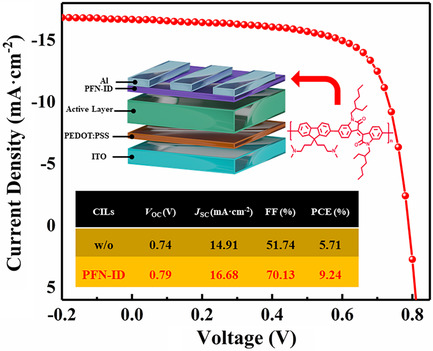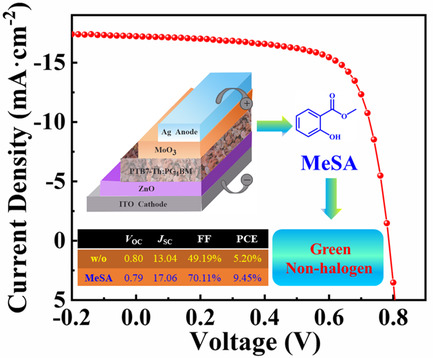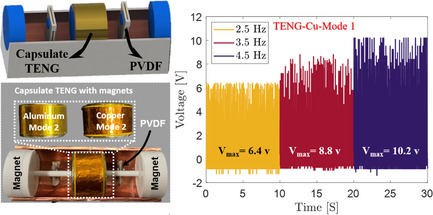Best of Energy Technology, 2022
Energy Technology proudly presents its “Best of 2022” Special Collection, featuring cutting-edge research encompassing energy generation, conversion, storage, and distribution. This curated selection of 25 outstanding articles showcases advancements in diverse areas, such as battery technologies for e-mobility, waste heat to power conversion, organic & perovskite solar cells, grid-scale photovoltaics, direct methanol fuel cell, photoelectrochemical CO2 reduction, hybrid solar lighting system, triboelectric clothing, and many more. In 2022, we received an impressive 1,500+ manuscripts, reflecting the growing interest in our journal as we entered our 10th year of publication.
We congratulate the authors whose works have been selected by our editorial team for this collection.
Many of these articles are published in Open Access, allowing you to freely access and share them. The remaining articles will also be free-to-read for a limited time.
We invite you to explore this collection of exciting research and review articles. We look forward to publishing more exciting research from you in 2023.
Evaluation of Deformation Behavior and Fast Elastic Recovery of Lithium‐Ion Battery Cathodes via Direct Roll‐Gap Detection During Calendering
Graphical Abstract

Herein, a novel method for gap detection is presented, allowing insights into electrode and machine behavior during calendering. Using this method, electrode springback (SB) of cathodes with various mass loadings and binder weight contents is investigated, showing linear correlation of the SB with applied line load. Based on these results, a first empirical model for SB is provided.
Drying of NCM Cathode Electrodes with Porous, Nanostructured Particles Versus Compact Solid Particles: Comparative Study of Binder Migration as a Function of Drying Conditions
Graphical Abstract
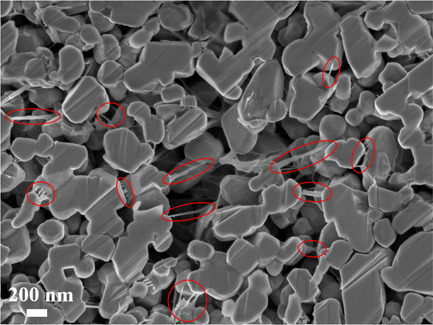
Herein, the properties of electrodes made of two different active materials at increasing drying rates and the binder distribution are comparatively investigated. When using porous nanostructured particles instead of solid particles, a significantly lower binder migration and a very low dependence of the discharge capacity at higher C rates on the drying rate are observed.
A Practical Guide for Using Electrochemical Dilatometry as Operando Tool in Battery and Supercapacitor Research
Graphical Abstract
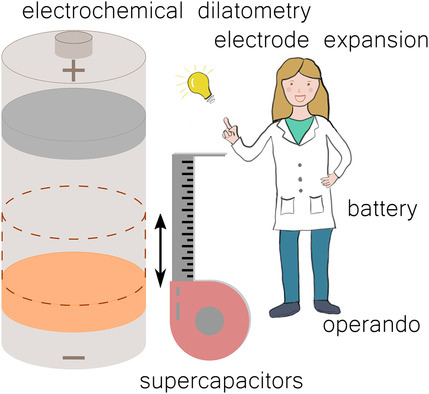
Electrochemical dilatometry is a powerful operando technique to measure the thickness change in an electrochemical device during cycling. Several studies have been published in recent years, investigating batteries and supercapacitors. This review presents selected examples from literature, a guideline on how to evaluate dilatometry data, and gives information on which effects have an influence on the data.
Understanding the Cathode–Electrolyte Interphase in Lithium‐Ion Batteries
Graphical Abstract
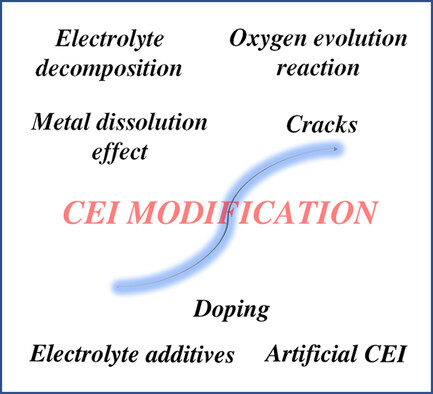
The cathode–electrolyte interphase (CEI) is much less understood compared with the solid–electrolyte interphase at the anode. This review discusses promising strategies to build a stable CEI, including electrolyte additives, artificial engineering, and heteroatom doping, as well as advanced characterization techniques to improve the fundamental understanding of the structural and chemical composition of CEI.
Detection of Lithium‐Ion Cells’ Degradation through Deconvolution of Electrochemical Impedance Spectroscopy with Distribution of Relaxation Time
Graphical Abstract
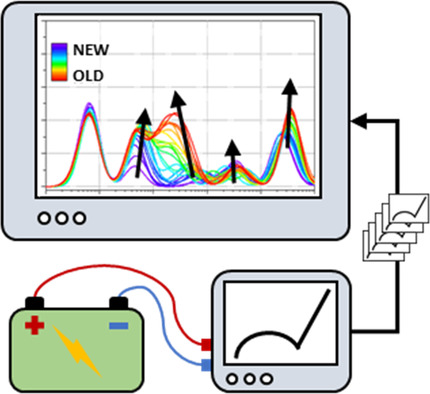
Herein, a methodology based on noninvasive characterization technique to detect degradation mechanisms is presented. Cells’ impedance spectra are deconvoluted to obtain peak-based representations to easily distinguish the occurring phenomena. The results are validated making lab cells and applying imaging techniques to the electrodes extracted by the commercial cells after aging tests.
Waste Heat to Power: Full‐Cycle Analysis of a Thermally Regenerative Flow Battery
Graphical Abstract
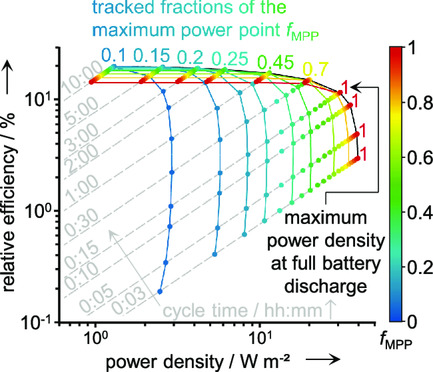
Thermally regenerative flow batteries (TRFBs) produce electrical power by exploiting waste heat below 100 °C. Performance strongly depends on the selected operating conditions. Here, a discharge strategy for the TRFB is developed, systematically evaluating the trade-off between relative efficiency and power density. The maximum power density is 38 W m−2, and the maximum relative efficiency is 20%.
Underpinnings of Multiscale Interactions and Heterogeneities in Li‐Ion Batteries: Electrode Microstructure to Cell Format
Graphical Abstract

Lithium-ion batteries exhibit a coupled set of electrochemical, thermal, and mechanical interactions ranging over different length scales. Herein, a hierarchical analysis spanning the role of electrode microstructure, cell format, and operating conditions on the underpinning heterogeneity in plating dynamics, thermal response, and mechanical stress distribution in lithium-ion batteries is developed.
Lithium‐Ion Battery Testing Capable of Simulating “Ultralow” Lunar Temperatures
Graphical Abstract
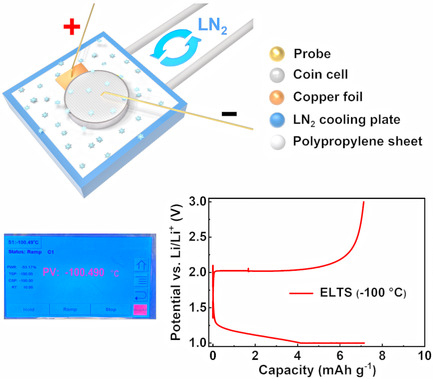
A battery testing system is developed to simulate extreme climate like the lunar surface, high altitude, and polar regions of Earth. Efficient liquid nitrogen flow and the tailored configuration enable the system to reach an extreme temperature of −175 °C. Furthermore, a Li4Ti5O12||Li cell produces a reversible capacity of 7.12 mAh g−1 at −100 °C for the first time.
Projecting Recent Advancements in Battery Technology to Next‐Generation Electric Vehicles
Graphical Abstract
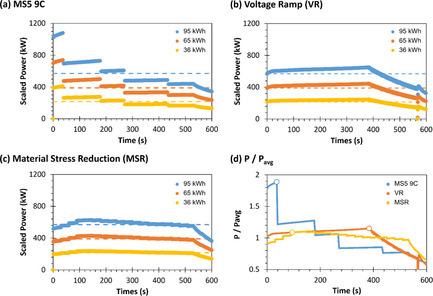
Scaling extreme fast charge protocols to relevant battery pack sizes provides an opportunity to understand how fundamental battery research links with infrastructure needs. Herein, it is shown that while some types of protocols may be advantageous to minimize aging, they are impractical when scaled. This information helps guide charge protocol development to increase charge acceptance and minimize infrastructure impacts.
Design Optimization of Energy-Storing Hybrid Supercapacitor Composite for Electric Vehicle's Body Panel
Graphical Abstract
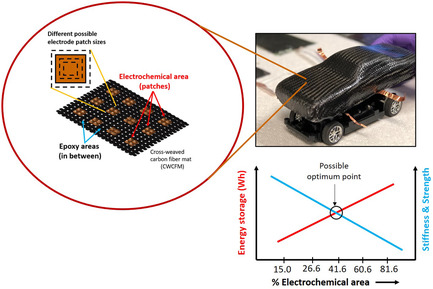
Design of the multifunctional “energized composite for electric vehicles” has been optimized using ANSYS simulation and experimental methods to obtain maximum electrical charge storage while maintaining a minimum mechanical strength. This has been achieved through evaluating the performance of the composite at various ratios of electrochemical area and epoxy area in each laminate of the composite.
Review and Development of Anode Electrocatalyst Carriers for Direct Methanol Fuel Cell
Graphical Abstract
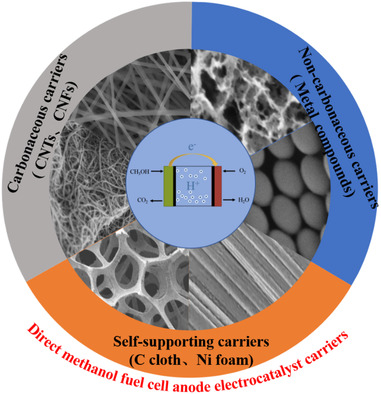
With the rapid development of electric vehicles and portable electronic devices, direct methanol fuel cell (DMFC) has received a lot of attention as an efficient alternative energy source. This paper reviews the research progress of different carbonaceous-based and noncarbonaceous-based catalyst carriers for DMFC anode catalysts in recent years, and gives an overview of the performance and development of self-supporting carriers.
High‐Entropy Materials for Water Electrolysis
Graphical Abstract
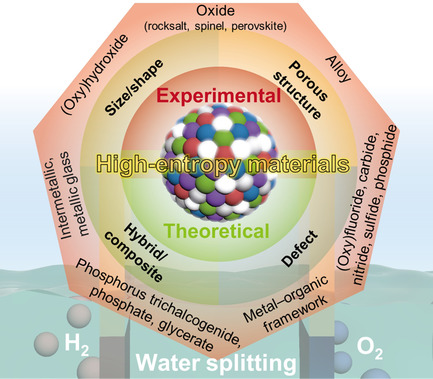
High-entropy materials are emerging as promising water-splitting electrocatalysts due to their compositional flexibility, structural stability, and synergy between different elemental components. Herein, the recent achievements in water electrolysis catalyzed by high-entropy materials, covering an overview of material candidates, a discussion of theoretical/experimental insights, a focus on materials design strategies toward improved catalysts, and perspectives on future research directions, are summarized.
Anion Exchange Membrane Water Electrolysis from Catalyst Design to the Membrane Electrode Assembly
Graphical Abstract

Hydrogen is an energy carrier, feedstock, industrial process gas, and alternative transportation fuel. Anion exchange membrane (AEM) water electrolysis is an efficient and economically feasible technology if cheap renewable electricity is available along with desired material and manufacturing scale-up advancements. This review describes the AEM electrolysis components and advances so far with an outlook on future challenges and potential research pathways.
Influence of Fermi-Level Engineering in Multi-Interface CuO/Cu2O||rGO||h-WO3||rGO|| Photoelectrodes on Photoelectrochemical CO2 Reduction
Graphical Abstract
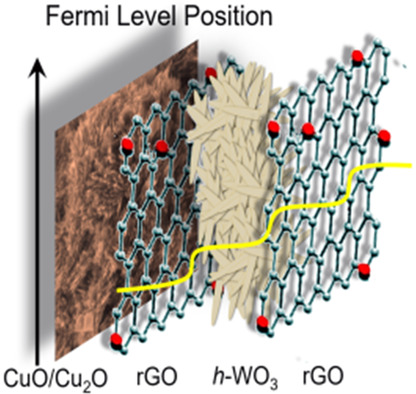
The enhanced photoelectrochemical (PEC) CO2 reduction performance is investigated by step-by-step multiinterface structure optimization, followed by band energetics alignment in CuO/Cu2O||rGO|h-WO3|rGO. Therefore, numerous postsynthetic treatments and geometries are explored for their usefulness for solar CO2 conversion to fuels. The findings provide an explanation for the nature of CO2 activation and relationship between its stability and other structural and spectral properties.
A New Alcohol‐Soluble Polymer PFN‐ID as Cathode Interlayer to Optimize Performance of Conventional Polymer Solar Cells by Increasing Electron Mobility
Improved Performance of Organic Solar Cells by Utilizing Green Non‐Halogen Additive to Modulate Active‐Layer Morphology
Novel Star‐Shaped Benzotriindole‐Based Nonfullerene Donor Materials: Toward the Development of Promising Photovoltaic Compounds for High‐Performance Organic Solar Cells
Graphical Abstract
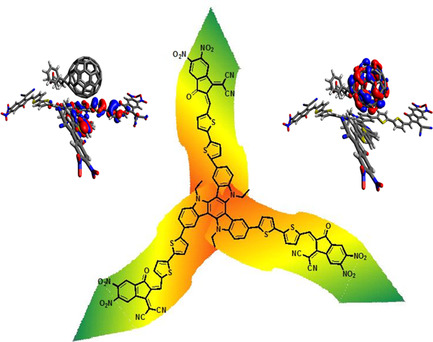
Seven novel star-shaped molecules are quantum chemically developed from the experimentally synthesized BTI(2 T-DCV-Hex)3 molecule. The designed molecules have proficient optoelectronic features, excellent hole and electron transfer mobilities, and can serve as best candidates for solar cell applications when blended with a PC61BM film.
Learning from Fullerenes and Predicting for Y6: Machine Learning and High‐Throughput Screening of Small Molecule Donors for Organic Solar Cells
Printable Low‐Temperature Carbon for Highly Efficient and Stable Mesoscopic Perovskite Solar Cells
Graphical Abstract
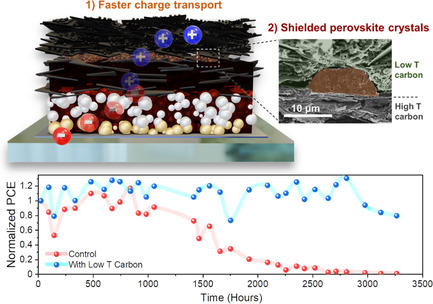
The moisture stability, thermal stability, and photovoltaic performance are improved in double-carbon layers configured with carbon-based perovskite solar cells (C-PSCs). The discovery of protruding perovskite crystals, which form from the excessive perovskite solution on the conventional C-PSCs, is investigated for the first time, and it is evidenced to be detrimental to device stability.
Inverted Hysteresis in n–i–p and p–i–n Perovskite Solar Cells
Graphical Abstract
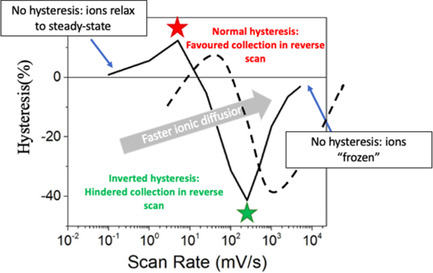
Hysteresis is a dynamic effect endemic to perovskite solar cells. Herein, it is demonstrated that under the right conditions, n–i–p and p–i–n cells can show normal or inverted hysteresis depending on the scan rate. Studies of inverted hysteresis are supported by a model allowing for coupled electron–ion motion.
How Does Location Determine the Economic Competitiveness of Grid‐Scale Emerging Photovoltaics?
Graphical Abstract
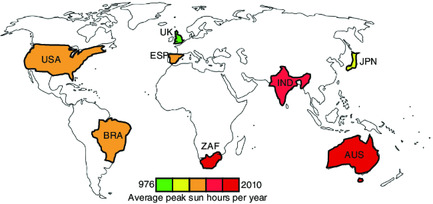
A technoeconomic model is used to examine how physical and human geography influences the cost competitiveness of emerging photovoltaic (PV) technologies based on organic and perovskite absorber layers. Our analysis spanning eight countries demonstrates that the relative importance of module cost, degradation, and initial efficiency varies between locations, motivating the consideration of locale when developing PV technology.
Selectively Harvesting Nonvisible Photons in Hybrid Solar Lighting Systems for Power Generation in Buildings
Graphical Abstract
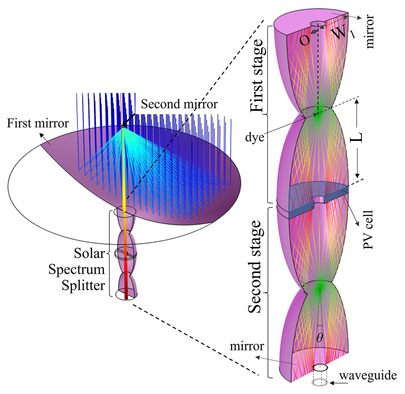
Hybrid solar lighting systems are integrated with parabolic- and elliptic-shaped solar spectrum splitters (SSSs) that partition collimated solar radiation into its visible and nonvisible parts. The nonvisible light is used to generate electricity in photovoltaic (PV) cells and the visible light is used for indoor lighting. A nonvisible-light-to-electricity conversion efficiency of ≈13.4% is achieved for light entering the SSS.
Design and Simulation of Single‐Electrode Mode Triboelectric Nanogenerator‐Based Pulse Sensor for Healthcare Applications Using COMSOL Multiphysics
Graphical Abstract
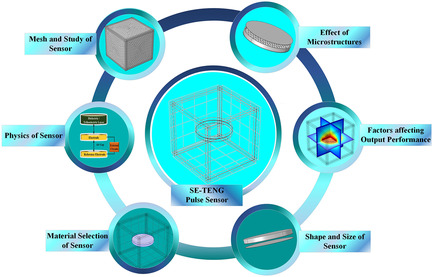
The single-electrode triboelectric nanogenerator wearable flexible pulse sensor optimization in terms of structure and material for pulse sensing application is done along with a study on the output performance improvement, thereby serving as a significant assistance for the rational plan of the device development even for a smaller range of displacement toward the wrist pulse measurement for disease diagnosis.
Thermoelectric Clothing for Body Heat Harvesting and Personal Cooling: Design and Fabrication of a Textile‐Integrated Flexible and Vertical Device
Graphical Abstract

Herein, scalable integration of the vertical thermoelectric device architecture and 3D-printed heat sink into daily clothing knitted fabric is demonstrated. The prototype maintains low electrical resistance (<1 Ω) over multiple bending cycles. The device achieves on-body power generation of 3.8 μW and a cooling effect of 1 °C, which is unprecedented for textile-based devices integrated into everyday clothing fabrics.




